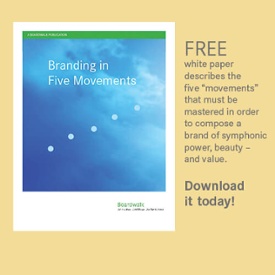Society impels us to conform but individualism drives us to stand out. Tribalism induces us to band together but curiosity draws us out onto lonely explorations. Where, as individuals, do each of us fall on that safety-seeking/risk-taking continuum? Where, on that same continuum, should we position our brands? And how do we make sure our brands can be recognized by kindred spirits – by the correct market? With all the tools available to marketers these days, visual style – semiology – is still the most direct, visceral connection to human beings. Businesses need to signal to their markets that they share values. That way, the market will feel safe in letting the brand into their lives. It’s all about showing the market something they recognize and trust. We can understand the phenomenon the moment we walk out onto a busy, urban street.
Human beings are visual hunters. We get 90% of the information around us through our eyes. Your brand has to look like what your market is hunting for. To get that to happen, you need to work with an excellent – professional – graphic designer. You have to give that designer useful directions so that he or she can put their talents in full service to your strategic objectives. You need to share a clear creative brief with that person, a brief that is the result of a well-thought-out brand strategy. That way, the designer can leverage the immense power of graphic design to attract the market (and the employees) that you want. She or he can integrate your brand strategy into your logo, your retail interior, your packaging, your online presence and every other aspect of your storytelling. Here are a few tips to ensure yours is the best it can be.
Topics: Identity
If you’re in a position to name something: a business, a product, an event, anything, please make it count for something. I recently witnessed a naming crime that was nothing short of tragic, on three different levels. Two family-owned companies with synergistic offerings decided to merge. Both companies had decent names. Not great but decent. Both names had meaning to the market. That is to say the market understood the origins of the names and what they stood for. There were existing market relationships with both brands. Either name would have been a workable moniker for the combined company. Either would have been a meaningful banner to carry forward. However, the owners decided that the new company should have a new name. Fair enough. Why settle for a good name when you can have a great one? But then the wheels came off the bus.
Topics: Identity
Man has always been a visual hunter. We get 90% of the information about our world through our eyes. At least that’s the way it’s always been. When hunting for food, primitive man would scan the savannah for signs of movement, for spoor or for tracks. For centuries we’ve relied on our eyes to navigate the world. Until now. Now we hunt online using search engines. Now we use voice command to find what we need. Back when we were visual hunters, branding best practices would dictate that consistency across all consumer touch points was essential. The logo has to look exactly the same on the business card, on the brochure and on the trade show booth. Likewise, the colors had to match exactly. Consumers were hunting for the products and services they needed and that visual consistency allowed them to recognize and identify their prey. Today, that consistency has to be extended to SEO and voice recognition. And it’s being done to excellent effect by Ford Trucks and Dennis Leary.
Topics: Identity
At some point in your brand’s history you’ll have to determine what sort of visual identity to employ. Should it be all sweetness and light, with pastel colors, heart shapes and curlicues? Or should it display large, aggressive color blocks of red, black and white, with big, bold typography that demands attention? Should your brand be a peacock or an eagle, or some other bird altogether? It’s a serious discussion because decision makers will use these visual cues to determine whether or not to let your brand into their lives. You have to remember what purpose your customers or clients have for you. Your product or service is a tool that they use to achieve something. What is it? Whatever their purpose is for you, you have to look like you can fulfill that purpose.
Topics: Identity
Sign up – Brandtalk

Best Branding Reads
Week of December 16, 2019
20 Big Ideas that will change your world in 2020
We’re going to have to reckon with some tough choices.
How Flaws Make A Brand More Appealing
There’s an art to turning your shortcomings into strengths.
On Trend: Fashion that Resonates with Young People
People want to wear brands that make them feel good about themselves.
Integrating Brand And Talent Strategy
Once again: The same brand strategy that attracts your best customer also attracts your best employee.
Fridge-Themed Logo Mascot
Yes. A sports team has a refrigerator as a mascot.
Trademark "Sound Mark" Examples
Thank you Mark N. for sharing this after last week’s Brandtalk. Have fun with this everyone. But, fair warning, it can get addictive.
H&M’s Greenwashing: Short-Sighted and Unethical
Be sure to watch the Michael Porter video.
Recent Posts
Posts by Topic
- Added Value (26)
- Brand Lens (1)
- Branding (2)
- communication (65)
- Devoted Customers (9)
- Growth (6)
- Identity (77)
- Increased Sales (8)
- Innovation (53)
- Positioning (86)
- Price Resiliency (3)
- Reduced Costs (2)
- Smarter Decisions (19)
- Strategy (104)
- Strategy, Price Resiliency, (1)
- Super Employees (5)






